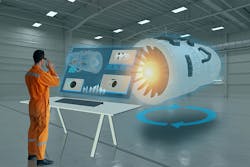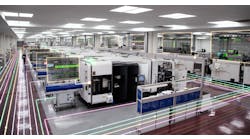The aerospace and defense manufacturing sector has a vast and complex supply chain – so it’s not a surprise that network the focus of the latest technological efforts to improve manufacturers’ performance and visibility. “Aerospace & Defense 4.0” is the term describing efforts to apply Industry 4.0 technologies in A&D manufacturing, for developing new cost-effective products and services, making existing products smarter using sensors and connectivity, and leveraging advanced manufacturing processes like additive manufacturing, among other objectives.
After a slow start “Aerospace & Defense 4.0” is quickly becoming a staple of the manufacturing sector. Now, for A&D 4.0 to continue its upwards trajectory, Manufacturing Execution Systems (MES) will have a vital role to play in getting critical data off the shop floor and up to the top floor.
As part of an IFS webinar examining the A&D 4.0 maturity curve, some surprising research results emerged. Only 12% of the A&D manufacturers in attendance said Industry 4.0 is not a business priority, but 68% were still in the research phase, to determine how it could help them reach their digital transformation goals – and that’s before they considered implementing the changes!
The path to A&D 4.0
The A&D market has indeed been slower to adopt 4.0 technologies because many businesses have held back, waiting for positive feedback from the early adopters before deploying the latest software.
But it is all changing, as many A&D manufacturers have adopted Industry 4.0 technologies. With new financial, operational, and security benefits A&D manufacturers are reaping the rewards of adding new technologies on top of their flexible enterprise software platforms.Adopting powerful Manufacturing Execution Systems (MES) is now pre-requisite to unlocking the full benefits of A&D 4.0 and has a hugely positive impact on production rates and execution, quality control, and Overall Equipment Effectiveness (OEE.)
MES coordinates inventory, production, and quality control activities to deliver efficient and compliant work execution by digitally tracking and documenting the end-to-end manufacturing process. These systems digitally capture each step of the transformation of raw materials into finished goods for documenting compliance, data-driven continuous improvement, and supply-chain transparency, in real time.
MES becomes vital to “vertical integration” of manufacturing by ensuring data is accessible from the shop floor to the top floor, continuously fed to real-time dashboards, and enabling control at every level of the manufacturing organization. From supervisors on the shop floor, to the director of operations, to the quality systems, and even in the C-suite, everyone in the chain has real-time information for actionable intelligence.
Critically, for A&D manufacturers, MES data must be able to address important details of their operations. Unlike traditional, discrete manufacturing of parts and assemblies, A&D equipment is held to higher standards of accuracy and safety. For example, engineering tolerances for aircraft can be as narrow as thousandths of an inch, and this could just be on an exterior panel! A&D MES support must have the ability to add additional 0.9 decimal places to manufacturing quality control.
It’s this level of quality and precision that MES in A&D manufacturing are held to, and these incredibly stringent tolerances are built-in for safety and mission effectiveness. Failure of either of these elements has consequences in A&D wherever the equipment is operating, with potential for catastrophic equipment failure to compromise mission success and even put the warfighter’s life at risk.
Having MES accessible as part of a core manufacturing solution offers significant benefits. First, separate MES is not conducive to providing the level of vertical reporting required in a modern manufacturing environment, nor is MES always able to provide the additional level of granularity and specificity necessary to operate in the A&D manufacturing sector.
However, working with complex point solutions with heavily customized integrations to solve these issues and move information across an A&D manufacturing organization is time-consuming to manage, and it risks soloing out data that would otherwise be critical to the overall production execution, quality control, and KPIs like OEE.
Built-in MES data tracking
It’s the MES that tracks the daily operation level of your shop floor. Software with built-in MES functionality provides the essential digital backbone between the proliferation of smart devices and machines and core manufacturing planning software, seamlessly integrating this technology with the higher-level software used to plan production. In this way, open interoperable MES solutions enable full traceability of parts, components, and projects — from design through to production and engineering.
As a pre-requisite, MES functionality should enable CAD integration, robust, real-time data collection, and more sophisticated integrations through IoT and RESTful APIs, as just a few examples. It also needs to support dispatching and shop-floor operation, improved production management and tracking, and quality management processes. Then there’s the need to enable machine monitoring and performance and KPI reporting.
Critically, instead of having to import a different MES and tie it all together with other manufacturing solutions, MES should be part of a single software package that's not simply integrated but a unified, fully connected product “out-of-the-box”. Once A&D manufacturers have established this connected base point in a single system, they can then exploit new and emerging automation functions that unlock further intelligent insights and accelerate automation efforts within their business practices.From an MES perspective, this may include streamlining to improve product quality control and performance and the use of artificial intelligence (AI) and historical data-driven work schedules, and job completion time, to improve accuracy for technical productivity.
Also, by combining IoT data with AI/machine learning, manufacturers can improve performances based on an array of historical observations and transactions.
All-in-one solution
Another common pain point for A&D manufacturers is working in the strict regulatory ecosystem associated with the U.S. Dept. of Defense supply chain, with stringent reporting requirements that are difficult to manage manually. Here, the benefits of an all-in-one MES and ERP system are huge. A shipping order, for example, would automatically go back to the ERP and then to the Defense Contract Management module for reporting and payment. Job done!
Within Defense Contract Management this streamlined approach between different operational areas of the business means A&D manufacturers can get automated reports done faster and more accurately — ultimately, to receive faster payment.
A&D manufacturers will not have to worry about spending large sums of money, undergoing business change, or waiting for a long implementation process with MES. Those changes will be swift and help to optimize processes. MES/ERP can help bring human capital benefits and help them fight against the labor shortage, the A&D manufacturing industry will need 3.5 million new workers by 2026, according to Future Aviation Aerospace Workforce.
Employees can be upskilled for higher level work, while increased feedback on MES data is making the factory floor automated. This data automation makes it easier to sell a process upgrade that opens up the factory floor to an army of robots; from a change-management point of view, this is massive progress! This is underlined by a recent McKinsey report that states:
“As the A&D industry evolves, re-skilling will be central to positioning the workforce to accommodate this evolution. Respondents indicated that the top three areas of investment in re-skilling are leadership (55%), engineering skills (45%) and cybersecurity (42%).”
As MES capabilities have grown, over time it has quickly become a critical part of A&D 4.0, especially to match the specific requirements of the A&D manufacturing sector
But MES cannot stand alone. MES must integrate with other A&D manufacturing systems in order to allow manufactures to achieve better production execution, quality control, and OKPI management.
Matt Medley is the Global Industry Director, Aerospace & Defense with IFS, an ERP software developer. Contact him at LinkedIn.








